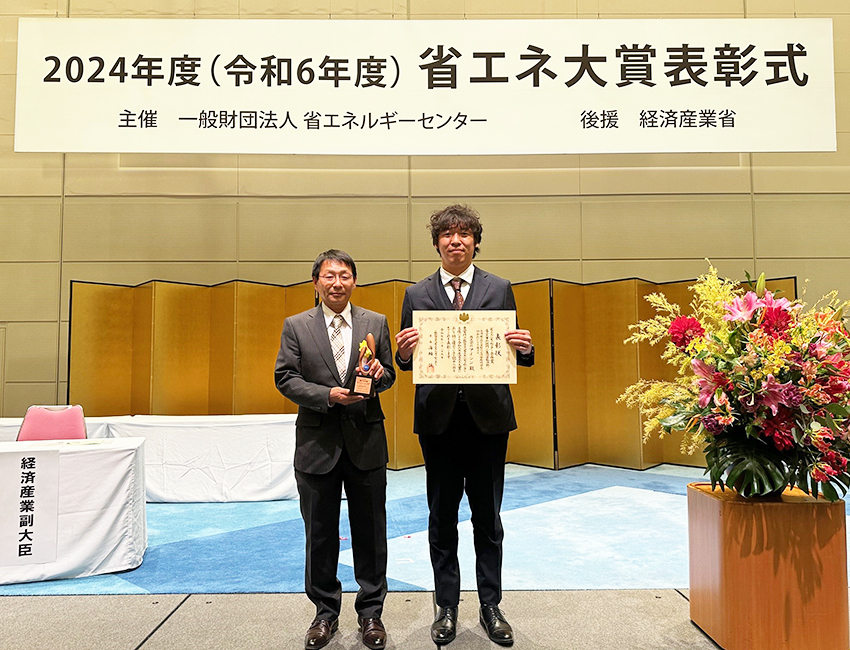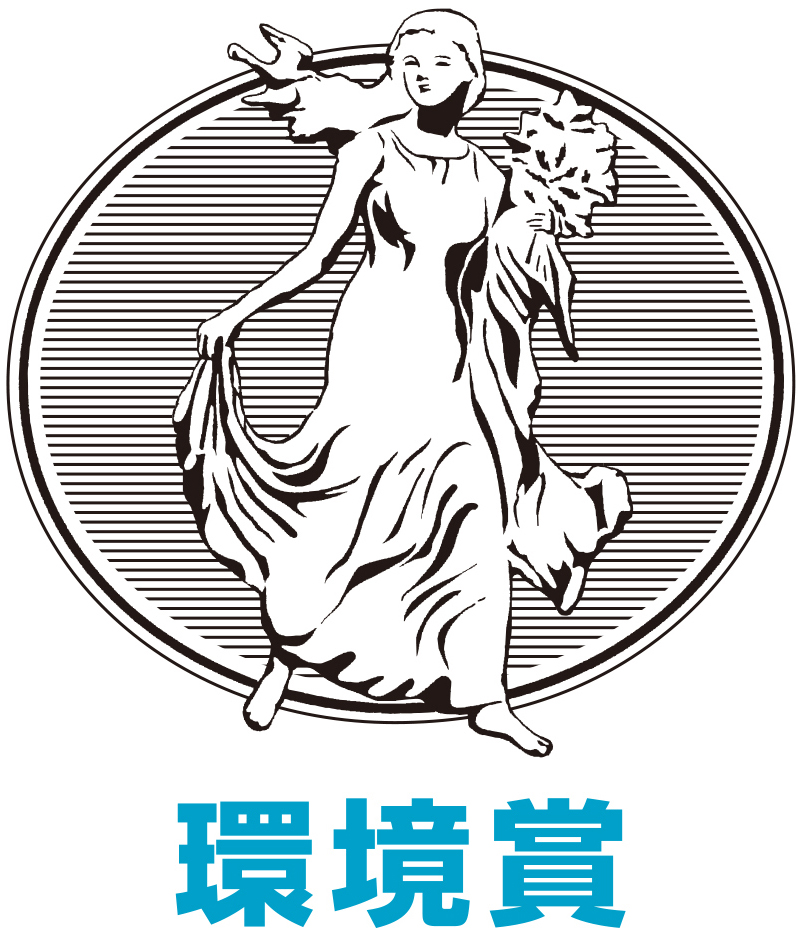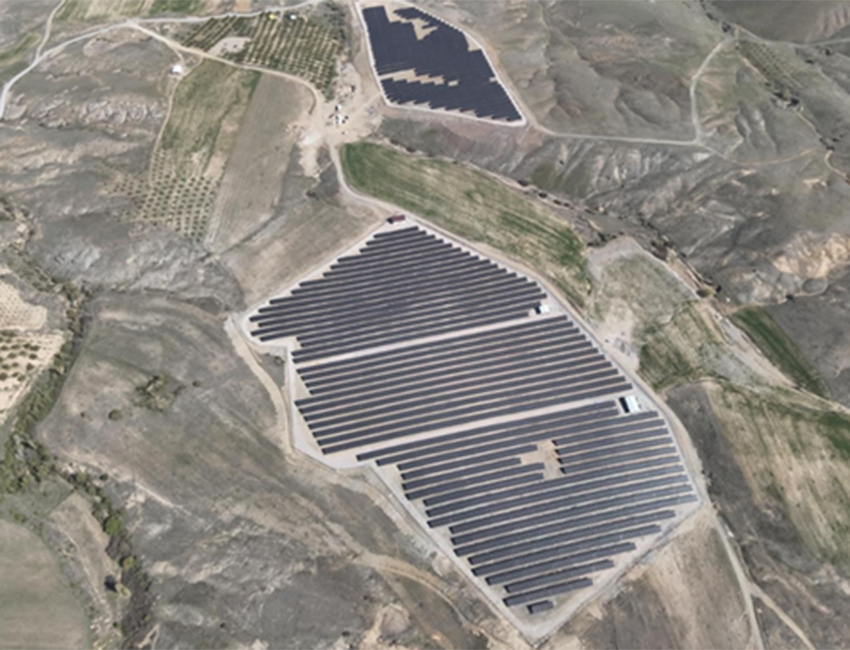Environment
Environment
Basic stance and policy
Building upon concepts such as legal compliance that form the foundation of our management, the Company prioritizes harmonizing with nature and contributing to a sustainable future through decarbonization, circular resource usage, and living in coexistence with the environment. By leveraging the vast product portfolio the Group has built that spans from automotive applications to construction, greening, and energy—combined with our leading technological skills and services—we aim to help address global environmental issues. We can thus continue bringing prosperity to the Earth of the future. Each Aisin employee is expected to sincerely confront environmental issues such as climate change and resource depletion. To leave on a sustainable environment for future generations, we aim to realize a society where everyone can live a relaxed and secure life in harmony with nature.
Resource circulation system to meet our goal of harmonizing with nature and contributing to a sustainable future

Promotion structure
In response to growing societal demand for environmental action, we renamed Carbon Neutral Promotion Center to the Carbon Neutral & Environment Promotion Center and strengthened its framework to holistically advance strategies and initiatives—from decarbonization, resource circulation, and coexistence with nature to environmental infrastructure activities.
In keeping with top-level policy, we hold regular meetings of the Environmental Committee and the CN/CE Promotion subcommittee to review, promote, deliberate, and monitor strategies related to building environmental infrastructure, decarbonization, resource circulation, and coexistence with nature. This enables swift and flexible decision-making.
Furthermore, important matters are submitted for discussion and reported to the Board of Directors. Business strategies and plans are revised as necessary to optimize management strategy.

| Convening body | Role | Main attendees |
|---|---|---|
| Environmental Committee | Deliberation and implementation of fundamental environmental policies based on higher-level directives Monitoring to ensure proper execution of environmental operations and minimize risks |
Group 13 Companies President Executive Officer in Charge of Environmental Policy |
| CN/CE Promotion subcommittee | Strategic review and promotion of decarbonization, resource circulation, and coexistence with nature | Group 13 Companies Executive Officer in Charge of Environment |
Strategy
We have defined harmonizing with nature and contributing to a sustainable future as our priority materiality issues theme and established the direction for reducing our environmental impact across the entire value chain. Specifically, we have set carbon neutrality (CN) and the circular economy (CE) as key goal indicators (KGIs) and are working towards them with established key performance indicators (KPIs).
Aisin has advanced environmental activities since FY 1994 by establishing a consolidated five-year Environmental Action Plan outlining specific initiatives. For FY2025, rather than building on past approaches, Aisin has put together its Aisin Environmental Action Plan 2031 by working backward from its desired future state to address environmental challenges from a unique perspective. With FY 2026 as a trial period, the entire group will advance activities toward full-scale implementation starting in FY 2027.
Related materiality issues
| Materiality issue | Goals (KGI) | Indicators (KPI) | FY2031 target values | |
|---|---|---|---|---|
| Priority issues | Path to realization | |||
| Harmony with nature and contribution to a sustainable future | Reducing environmental impact across the entire value chain | [Carbon neutrality] FY 2051: achieve CN 2FY 2036: achieve CN for CO2 from manufacturing |
Scope 1 & 2 emissions | 46.2% decrease compared to FY2020 |
| Scope 3 emissions | 27.5% decrease compared to FY2020 | |||
| [Circular economy] Achieve zero-emission factory by FY 2041 (Landfill waste ≤1%) |
Resource efficiency | 10% efficiency improvement* | ||
| Waste minimization Waste emissions |
11% decrease compared to FY2020 | |||
Resource efficiency: sum of the waste discharge reduction rate and the rate of increase in waste recycled for use within the group
Key initiatives
Carbon neutrality initiatives
Scope 1 & 2
We are reducing energy consumption through rigorous energy-saving activities and the development and introduction of innovative production technologies. Furthermore, we are progressively switching our electricity supply to solar and wind power and renewable sources. We are advancing the replacement of non-electric energy by way of electrification while promoting CO2 separation, capture, reuse, and substitution with new energy sources.
Our energy conservation initiatives dictate the strengthening of groupwide efforts to assess the energy consumption of each piece of equipment and process used in producing a single product and eliminate waste. Among these efforts, the Energy Conservation Center Chairman's Award was presented for an idea involving the intermittent operation of cleaning equipment at that organization’s FY2025 Energy Conservation Awards ceremony. By shifting to small-lot cleaning processes, powering down idle equipment, and applying inverter control tactics, we reduced annual electricity consumption by approximately 27% (a decrease of 12,453 kWh compared to previous levels).
Furthermore, the executives responsible for sustainability matters tour domestic and international factories to personally verify CN and CE initiatives on-site. They engage directly with personnel to identify challenges and implement countermeasures. We will continue devising new energy-saving initiatives and share existing ones beyond the Group with external parties in an effort to contribute to CO2 reduction at the societal level.

We are reducing CO2 emissions while maintaining production capacity through innovative production technologies, such as power and heat source reduction, unmanned operation, and the development and use of ultra-eco equipment.
This time, the “Room-Temperature Rust-Preventing Cleaner” jointly developed with Kao Corporation has received the Grand prize of Minister of Economy, Trade and Industry at the 52nd Environment Awards hosted by the National Institute for Environmental Studies and Nikkan Kogyo Shimbun, Ltd. Combining three key functions—high cleaning effectiveness at room temperature, high drying efficiency without the need for hot air, and high rust prevention that obviates the need for rust treatment—this process achieves a 73% reduction in CO2 emissions versus conventional cleaning machines and reduces the need for rust prevention materials.
Furthermore, extending the usage period of the cleaning solution reduces water resource consumption to less than one-third and lightens the load on wastewater treatment.

Europe has set its long-term target deadline for carbon neutrality at 2040, which is earlier than Aisin's goal. As a first step toward achieving 100% renewable energy usage at all European production sites, the Company has advanced its transition to renewable energy sources, such as solar and wind power generation. In April 2025, Aisin Otomotiv Parçaları San. Tic. A.Ş (Istanbul), an Aisin production subsidiary based in Türkiye, constructed a solar power facility within Türkiye. The commencement of power generation at this facility pushed the renewable energy adoption rate to 100% across all production sites in the European region, including Türkiye.

Aisin handles raw materials and runs a variety of heat-intensive production processes, which presents challenges for Scope 1 reduction. Aisin Takaoka has developed a biofuel, Bio-M-Coke, as an alternative to coking coal used in iron smelting. The company has conducted demonstration tests replacing 100% of its production line with bio-briquette coke, confirming stable operation under normal conditions. Concurrently, demonstration tests are progressing at domestic partner foundries, with sales of this product scheduled to begin around autumn 2025.

Scope3
We are focusing emissions reduction activities on the four categories (1, 4, 11, 12) that account for the largest share of CO2 emissions across the entire production lifecycle, from resource extraction through disposal.
Specifically, in addition to reducing CO2 during use by improving the performance of our products, we are working on CO2 reduction activities across the entire supply chain. This includes promoting the adoption of low-CO2 materials, supporting suppliers’ carbon neutrality programs, and collaborating with suppliers and transport services to improve loading rates and optimize routes. These initiatives lessen our environmental impact while also raising our competitiveness as a company.
To tackle CO2 reduction from the initial stages of development, we incorporate lifecycle assessment (LCA) into our product designs. We use measuring tools in accordance with internal assessment guidelines to quantitatively evaluate the LCA of our products. Moreover, we have integrated LCA education into our companywide training system to enhance our employees’ understanding and improve their assessment skills. By adopting low-CO2 materials and introducing smaller, lighter products starting at the early development stage, we reduce CO2 emissions throughout the entire product lifecycle.
Our efforts have been recognized and, in March 2025, we were certified as a Five-Star Low-Carbon Supplier by the China Automotive Technology and Research Center (CATARC).
Life Cycle Assessment (LCA): Quantitatively evaluates the environmental impact throughout the entire life cycle of a product or service.

We have been working with suppliers since FY2022 to reduce CO2 emissions within the supply chain. To date, we have established three platforms for continuous engagement: CN Base Camp for learning the fundamentals of carbon neutrality, CN Open Campus for learning about other companies' initiatives and new information, and CN Activity Support for practical application leading to results. Starting in FY2024, we have strengthened our framework for advancing initiatives together with suppliers by matching our factories with suppliers by industry sector. This enables onsite, hands-on sharing of best practices and activities for mutual learning. Moving forward, under the slogan “Leave no one behind,” we will continue to promote CN activities across the entire supply chain in consultation with our suppliers.

As part of our efforts to reduce material usage, we have been working to achieve cascade use resin runners created during reservoir tank manufacturing for other products within the group. As a result, we have successfully utilized this excess material as a core input for sheet products. This reuse of runners is practiced across the entire group. Through the circular use of resources in the smallest possible cycles, we are reducing purchases of new materials and minimizing CO2 emissions.
Circular economy Initiatives
We are promoting such activities as effective resource use and minimization of waste to achieve zero-emission factories by 2040. Moreover, circular resource usage initiatives applied across the entire supply chain have also proven effective in reducing Scope 3 emissions. We target all items involved in our business activities: raw materials, auxiliary materials, production equipment, molds, jigs, packaging materials, etc., for conversion into recyclable states through disassembly, sorting, and promoting eco-design, thereby advancing resource recovery. As this is difficult to achieve on our own, we promote the adoption of recycled materials in collaboration with industry, government, and academia and through our participation in Toyota Group task forces.
Circular resource usage diagram

Effective resource use
We effectively use resources by cutting material usage through product weight reduction and miniaturization, waste minimization, value enhancement, reduced use of auxiliary materials, and a lower ratio of new materials and products introduced. Our products and manufacturing technologies are designed from the outset to minimize scrap and waste. For unavoidable manufacturing byproducts like scrap and chips, we rely on recycling and enhance value through waste separation.
At Aisin’s Handa electronics plant and Aisin Tohoku, the initial work-in-process (WIP) items used the same resin and metal used in the final products, resulting in metal waste. To address this, we replaced the metal parts with dummy components made from recycled materials for the WIP, thereby reducing wasted metal. We are spreading improvement techniques like this across all of our factories and Group companies, working groupwide to optimize our use of resources.
Minimizing waste
As part of our Group’s effort to convert industrial waste that would otherwise end up as landfill into usable materials, which is achieved by reducing the amount of waste created and improving production process technology, Aisin Takaoka, found that during casting approximately 5% of waste from sand molds was not recyclable and destined for landfill disposal. This non-recyclable landfill waste was sorted, cleaned of foreign matter, and used as a raw material for cement. As a result, recycling rates increased by 80% compared to the previous year.

Other Initiatives
Reduced water usage
Aisin's business activities rely heavily on natural capital, making the lighteing our environmental impact an essential goal. Aisin has established six principles for water reduction and is working to cut water usage. Focusing particularly on a Stop, Reduce, Substitute, and Recycle model, we implement measures such as ensuring thorough shutdowns when lines are idle to reduce water pressure and flow rates, switching to waterless processes, recycling wastewater, and using rainwater and drainage runoff. To illustrate the “Substitute” perspective, at the Nishio Die Casting Plant, water had been used for cooling when applying release agents to high-temperature molds. However, the adoption of conformal cooling molds enabled efficient internal cooling and eliminated the need for water altogether. Additionally, release agent aerosol was previously recovered and treated using water. However, by employing special filters for processing, waterless recovery is now possible. We are promoting the expansion of such advances across our various factories to reduce water consumption.
Harmony with nature
Aisin promotes activities that promote harmony with nature according to three pillars: watershed conservation, collaboration with local stakeholders, and contribution to ecosystem network development. In FY2025, we expanded our global natural harmony activities beyond the cleanup activities conducted around many manufacturing sites to include tree planting, protection of rare species and removal of invasive species, and river and coastal cleanup. Furthermore, under the “Green & Blue Project,” which aims to plant 800,000 trees by FY2031, we achieved a cumulative total of 359,000 trees planted as of end-FY2025.
We define facilities that comply with all three pillars described above as Aisin Group Nature-Harmonized Factories. In FY2025, we certified one new facility, bringing the total to five. We aim to have certified a total of 10 facilities by FY2031. Moreover, we have begun to educate all employees, including management, to provide a platform for everyone working at Aisin to learn about nature positivity and understand its connection to our business.
Global implementation status of activities aimed at harmonizing with nature

Circle size indicates number of activities
Foundational activities
Environmental management
To ensure environmental initiatives are reliably promoted at all locations, the Company shares its Aisin Consolidated Environmental Policy across all Group companies.
In 2008, we established EMS working groups, which meets four times a year focusing on three pillars: standardization, human resource development, and assessment. At monthly meetings with environmental managers at our six overseas headquarters, we ensure compliance with environmental laws and prevent major environmental incidents.
Standardization
Since 2018, the entire Group has implemented the Aisin Global Environmental Standards (AGES) to identify potential environmental risks, such as environmental accidents, pollution, and legal violations. We are working to prevent or minimize environmental risks across seven key areas: wastewater, air, solid waste, noise and vibration, soil and groundwater, odors, and management of relevant subsidiaries, suppliers, and customers. Reflecting on past environmental incidents, we are strengthening regulations, employee training, and audits to prevent recurrence.
EMS enhancement cycle

Human resource development
To achieve a consistent level of environmental management across the Group, we have promoted the harmonization of manuals and standards since 2022. Operations directly linked to environmental law violations, accidents, or abnormalities are restricted to company-certified personnel, with mandatory education and on-the-job-training every three years. We will continue to develop expert staff for operations requiring specialized knowledge and skills to prevent environmental law violations and accidents.
Assessment
At Aisin, 90% of our Group companies have obtained and maintain certification for their Environmental Management System (ISO 14001 international standard). However, we have discovered inconsistencies in the implementation of systems, procedures, and management standards across Group companies that pose challenges to the early detection of environmental incidents and aberrations. Therefore, starting in FY2025, we strengthened our control structure by initiating the integration of management reviews and standardizing key themes for internal audits.

